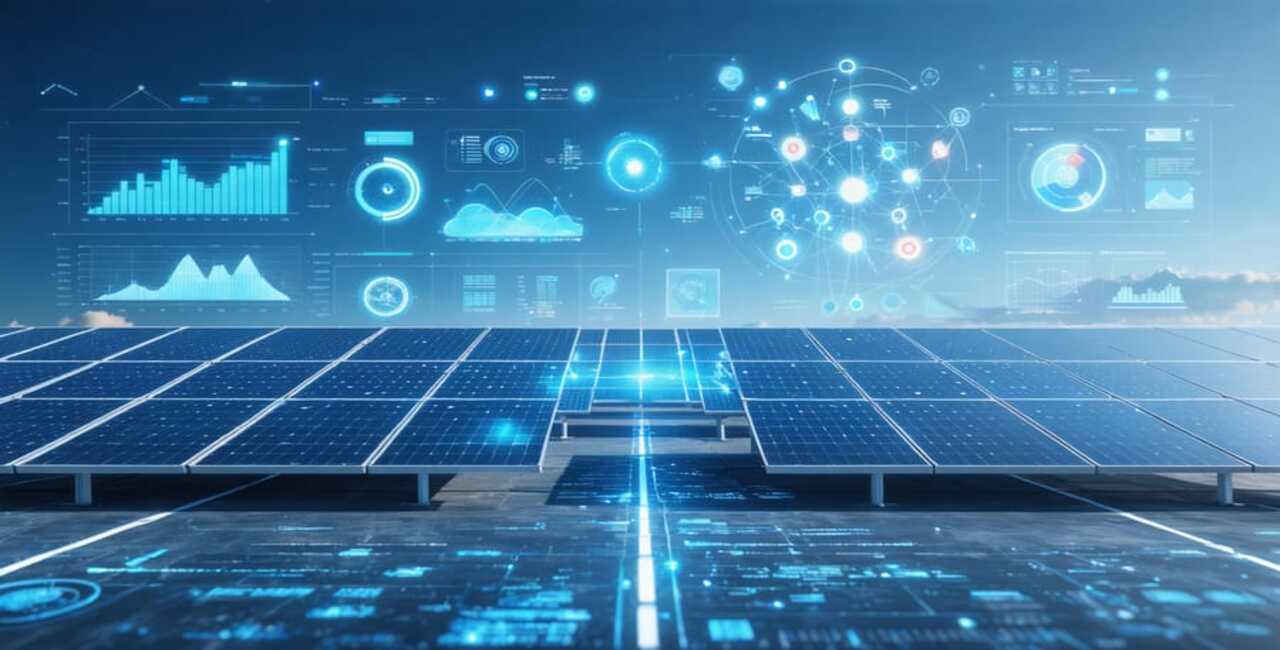
The design phase has always slowed down the solar projects. Creating a detailed solar layout, calculating energy output, and optimizing for cost and efficiency takes time and precision.
That’s where artificial intelligence (AI) is changing the game. AI-powered solar design software can now do in minutes what used to take hours turning complex, technical work into automated solutions that boost both speed and accuracy.
AI-powered solar design software uses machine learning, real-time environmental data, and performance prediction to automatically generate optimized layouts, component sizing, and simulation models—accelerating system design while improving precision and reliability.
In this article, we’ll explore what AI really means in solar design, why it’s becoming essential in 2025, and how it’s helping EPCs and solar professionals deliver faster and more reliable projects.
AI in solar design is about replacing manual steps with intelligent automation. In traditional solar projects, designers use CAD tools and spreadsheets to create layouts, run performance simulations, and size components. It’s a detailed work but it’s slow and prone to human error.
AI changes that. Instead of following fixed rules, AI tools learn from large sets of real-world data things as past system designs, performance records, weather data, and satellite imagery. Using that information they can instantly generate optimized designs that balance cost and output.
In simple terms, AI takes all the site information (like roof shape, shadows, or nearby trees), processes it through smart algorithms, and creates a system layout that delivers the best energy output possible.
A typical flow looks like this:
Site data → AI analysis → Optimized layout & simulation.
Unlike traditional design tools that just draw and calculate, AI tools actually think. They analyze patterns and outcomes to continually improve. That’s why solar design software powered by AI can deliver not just speed, but also better decision-making and long-term accuracy.
.png)
The timing for AI adoption in solar is a result of the industry’s rapid evolution. By 2025, many factors are pushing EPCs, installers, and developers toward smarter design systems.
1. More advanced AI and machine learning models
AI tools have become far more accurate because they now train on millions of data points from real-world projects. They can predict energy production, shading losses, and temperature effects with exceptional reliability.
2. More complex system designs
Now solar is not limited to panels on a roof. Projects today include bifacial panels, battery storage, and EV integration. These systems require advanced optimization that manual methods can’t handle efficiently but AI can.
3. Pressure to deliver faster proposals
In the solar business, the company that sends the first accurate proposal often wins the deal. AI software can generate same-day proposals by automating layout, energy simulations, and financial estimates — giving teams a real competitive edge.
4. Higher reliability expectations
With more systems being financed and monitored long-term, reliability is critical. AI tools can predict issues like shading, module aging, or performance mismatch before they happen, reducing the risk of underperforming systems.
In short, 2025 is the year AI design shifts from a “nice-to-have” to a “must-have,” helping EPCs scale faster and operate smarter.

AI design tools come with features that make the entire solar design process faster, more accurate, and easier to manage. Let’s look at the core capabilities driving this transformation.
AI can automatically place solar panels, detect obstacles, and adjust the layout for maximum energy generation. It optimizes every inch of space, ensuring that panels are positioned for the best possible sunlight exposure.
This feature is especially useful for complex rooftops or uneven terrains, where manual placement can take hours. The result is a layout that balances energy yield and installation practicality in a fraction of the time.
AI doesn’t just draw layouts — it predicts how the system will perform. Using weather data, solar irradiance, and temperature trends, AI simulates how much power a system will generate throughout the year.
It also accounts for factors like shading, dust accumulation, and degradation over time, helping EPCs present realistic performance estimates and stronger financial justifications to clients.
Manual electrical design can be tedious and prone to mistakes. AI tools automatically size strings, balance DC/AC ratios, and select compatible inverters. They also ensure designs meet voltage limits and grid codes.
This automation reduces design errors and eliminates the need for repetitive recalculations when equipment or system capacity changes.
One of the most powerful uses of AI is connecting design tools to real system performance data. By analyzing IoT and monitoring data, AI can identify where a system is underperforming and feed that information back into future designs.
Over time, this creates a self-improving design loop every new project gets smarter based on the performance of the last.
AI-powered tools can instantly compare multiple design scenarios. For example, you can see how adding a battery, switching module types, or changing tilt angles affects performance and cost.
AI doesn’t just make the design process faster, it helps solar systems perform better for years.
By combining AI design with performance monitoring, EPCs can track how a system behaves after installation. Sensors collect data on power output, temperature, and shading conditions. AI then analyzes this data to detect early signs of problems like dust buildup, partial shading, or faulty strings before they cause significant losses.
When these insights are looped back into the design phase, engineers can refine future layouts to avoid similar issues. This continuous feedback cycle means each new project becomes more efficient and reliable.
In essence, AI doesn’t just optimize one design, it improves every design that follows.
Adopting AI design software doesn’t mean overhauling your entire workflow. The transition can be smooth if approached step by step.
1. Review your current workflow.
Identify which parts of your process take the most time for example, shading analysis or electrical sizing. Those are the best starting points for automation.
2. Start with a pilot project.
Test AI tools on a small set of designs. Track results like turnaround time, energy prediction accuracy, and proposal win rate.
3. Integrate with your existing systems.
Many AI tools connect easily with CAD, GIS, and proposal software, making data transfer seamless. This keeps your workflow familiar while adding smart automation.
4. Train your team.
AI tools are user-friendly, but training helps your team understand how to interpret results and make the most of automation.
5. Scale gradually.
Once you’ve seen the benefits, expand AI adoption across more projects. Combine it with monitoring data to create a fully connected design and performance ecosystem.

AI solar design software delivers measurable results both in time and money saved.
Let’s look at a simple ROI formula:
(Hours saved × cost rate × number of projects) – software cost = net ROI
If your team designs 100 systems a month and AI cuts design time by 75%, the time savings alone can offset the investment quickly. But the impact doesn’t stop there.
AI tools reduce rework and design errors, which lowers construction delays and warranty claims. They also help teams deliver proposals faster, improving conversion rates.
In many cases, companies report 4x faster design turnaround, up to 25% higher energy yield, and 30% lower operational costs, all because of smarter and data-driven design automation.
For EPCs and solar developers, the numbers speak for themselves: AI is a technical upgrade and a business growth engine.
AI’s next big step is generative design — where the system automatically creates layouts based on just a few inputs like location, roof size, or energy target. Instead of manually adjusting every parameter, designers simply set goals, and the AI generates multiple optimized options to choose from.
As sensors and IoT devices become more advanced, solar systems will move toward self-optimizing designs. These systems will use real-time data to automatically adjust parameters such as inverter settings, tilt angles, or battery usage to maximize performance.
Soon, AI won’t just design solar systems — it will help them continuously improve themselves throughout their lifespan. That’s the future of truly intelligent solar technology.
Is AI design accurate and safe for real projects?
Yes. AI design tools follow engineering standards and use verified data models to ensure safety and compliance.
Can smaller EPCs afford AI solar design software?
Definitely. Many AI tools are cloud-based with flexible pricing, making them accessible for companies of any size.
Does AI replace engineers?
No. AI handles repetitive, data-heavy work, allowing engineers to focus on decision-making, customization, and quality control.
Is data safe with AI tools?
Yes. Reputed platforms use secure, encrypted cloud storage and comply with data privacy standards.
.png)
Artificial intelligence has turned solar design into a faster and a more reliable process. What once took days of manual work can now be completed in minutes with higher precision and less risk of error.
Arka360’s AI-powered design engine automatically generates optimized layouts, shading analysis, and energy simulations all within minutes, helping EPCs design faster and more accurately than ever before.
To explore how AI can simplify your solar workflow, visit arka360.com or learn more about our AI solar design software and see intelligent automation in action.













